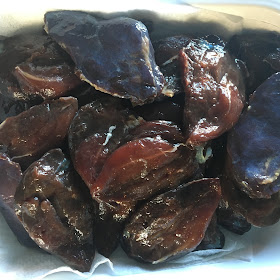I have wanted to experiment with cooking something in a pit in the ground for a long time; a lamb or a pig, out in the wild... surrounded by nature, digging up beautifully cooked meat, grilling lovely vegetables on the fire... I watch Francis Mallman on 'Chef's Table' with envy, and make plans to light fires, cook whole venison and river trout at the top of a deserted valley with friends and family one summer. I'll send out invitations with just a little map; everyone will walk for miles to the delight at the end, maybe no one will want to come, but I will! However, if I'm ever going to actually attempt that I needed to practice; because that's not just going to fly on the first attempt!

So a few weeks ago we set off to the lakes with a big leg of lamb and a vague plan. I read various websites and put together an idea of what I might do. In short, dig a hole in the ground, fill it with stones, burn a fire until the stones are red hot, put the lamb in, cover with soil and turf and hope for the best...
I settled on a cooking time of 12 hours, various times were mentioned on line but this allowed us to leave it in all night, get it out in the morning, and have time to rescue it if needs be before guests arrived for lunch. So we had to forgo the 'big reveal' of digging it out of the ground to the waiting crowd, but it seemed like the sensible thing to do as I had read reports of joints being burnt on the bottom and raw on top and various other disasters...



The hole in the ground needs to be deep enough to accommodate a layer of large stones at the bottom, the lamb in the middle, more stones on top and then a layer of soil and turf, so we ended up with a pit about half a metre deep, measuring about the same in width and length.
We collected stones from the river, going for pretty large ones, as they need to retain the heat for a long time, about the size of your head I read, I chose slightly smaller ones as I had to carry them! The idea is to heat them as hot as possible, burning a fire around them for a good few hours, letting your fire eventually disappear , leaving you with stones that are about 200/300 degrees.





We lined the bottom and the edges of the pit with the stones, then placed a few more in the middle that we ear marked as the ones that we would then lift up and put on top of the lamb when it went in. Then covered the whole lot with kindling and logs and got going with the bonfire, gradually adding more logs as it burnt bigger, building it up to heat all of the stones. I think we burned it for about 3 hours in the end. It was very enjoyable sat round faffing about with the fire, a glass of wine in hand, excited to put the lamb in and wondering what on earth was going to happen.
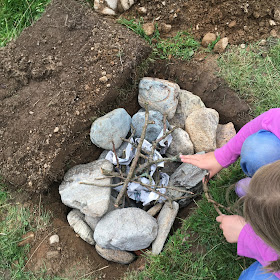


I marinated the leg of lamb in garlic, rosemary, lovage, olive oil, lemon juice, salt and pepper and left it out to come up to room temperature while we got the fire going. Before it goes in it needs to be wrapped up very tightly in foil, do this carefully as you don't want all the lovely juices to leak out, I used quite a few layers. Then wrap it in an old damp towel or a damp burlap sack. This creates a barrier between the lamb and the red hot stones and prevents burnt spots.

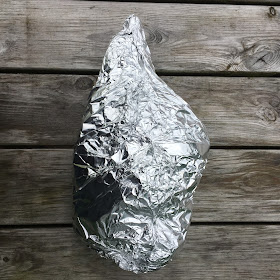

The fire burnt and burnt, we moved the logs around so every stone was enveloped with heat and slowly we let it burn right down, pushing the embers away into the gaps between the stones, until it had all but disappeared and we were left with red hot stones. It took about 3 hours in the end; it is worth taking your time over this bit as if the stones haven't heated right to the core they aren't going to be very good at cooking your lamb for 12 hours. Obviously this is a difficult thing to assess, testing the middle of stones, but I figured a long, long fire was the answer.


Then the parcel of lamb is placed in the middle. We had big fire proof gloves to lift out some of the stones, put the lamb in place then put some stones back over the top, so all surfaces were covered. It was starting to get dark at this point and the heat was so intense, it was a bit of a frantic getting everything into place... Then dig the soil back over the top, covering the whole thing so no little jets of steam and smoke are escaping, finally placing the square of turf back over the whole thing and stamping it down, you shouldn't be able to feel any heat coming out at all. Almost as if nothing had happened.
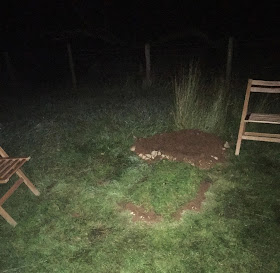
Night had begun to fall and we were shoveling soil back into the pit by the light of an iphone, anyone passing may have thought we resembled a scene from Midsummer Murders... It was all very exciting to see what we would find in the morning!
It was a really cold night and there was a icy dew covering everything when I went outside at about 9am and you could see your breath. I could see patches of dry soil and around the edge of the turf top, and the ground felt warm when you put your hand to it... joy! it had actually stayed warm overnight, so something must have happened... We carefully lifted the turf lid then began to dig away the soil, slowly uncovering the lamb bundle. It was a warm bundle when lifted out, and unwrapped the lamb was actually cooked! Lovely smells wafted out as I unwrapped it, finding soft, cooked, aromatic lamb, actually cooked!




It was pretty anaemic looking, it doesn't colour at all as it is basically steaming in its little bundle, so there's no great 'wow, look at that transformation' moment, it's just cooked. But it felt pretty good that we'd managed to actually cook it with just some stones and a fire. For lunch I put it in the oven to heat through and crisp up, it was very tasty sat at the long table next to the pit with the carved up lamb, big salads, bbq potatoes and vegetables, a smoky aubergine yoghurt, mint syrup, spicy tomato sauce and everyone tucking in.


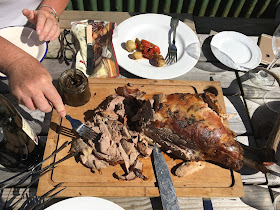

I'm keen to try it again as soon as possible. There are some things I would like to improve on. When we took it out of the ground it was warm, but not hot, and would have needed a blast of heat from an oven or bbq regardless, so I think I left it in a bit too long, or, the stones could have been hotter to start. The lamb doesn't fall apart as it would in an oven braise, you had to carve it into slices, and I think perhaps it didn't reach a high enough temperature for long enough, so again, perhaps heating the stones better at the beginning might improve this. That said it was a pretty satisfying day all round! I'll report back on take two...







